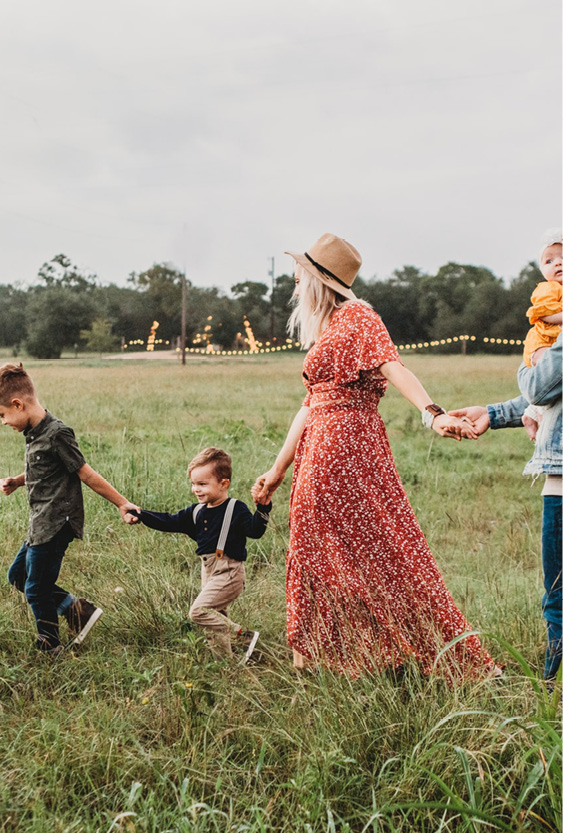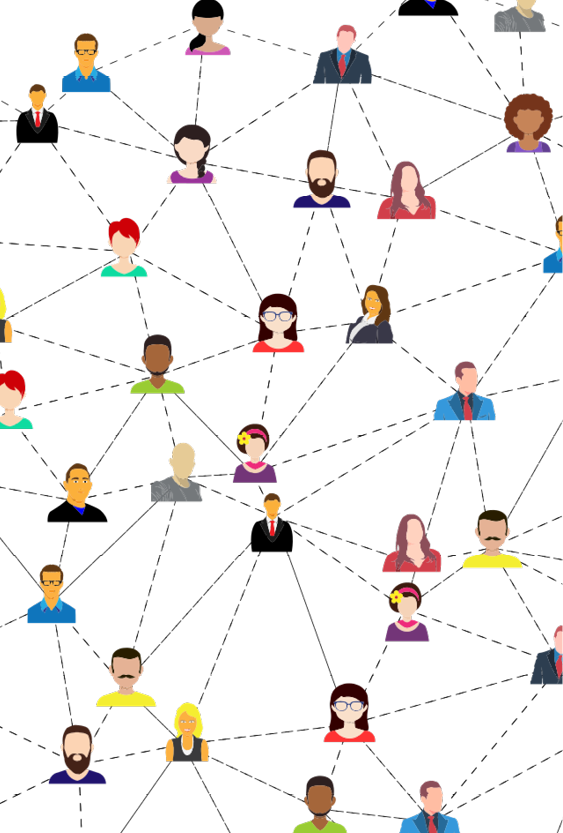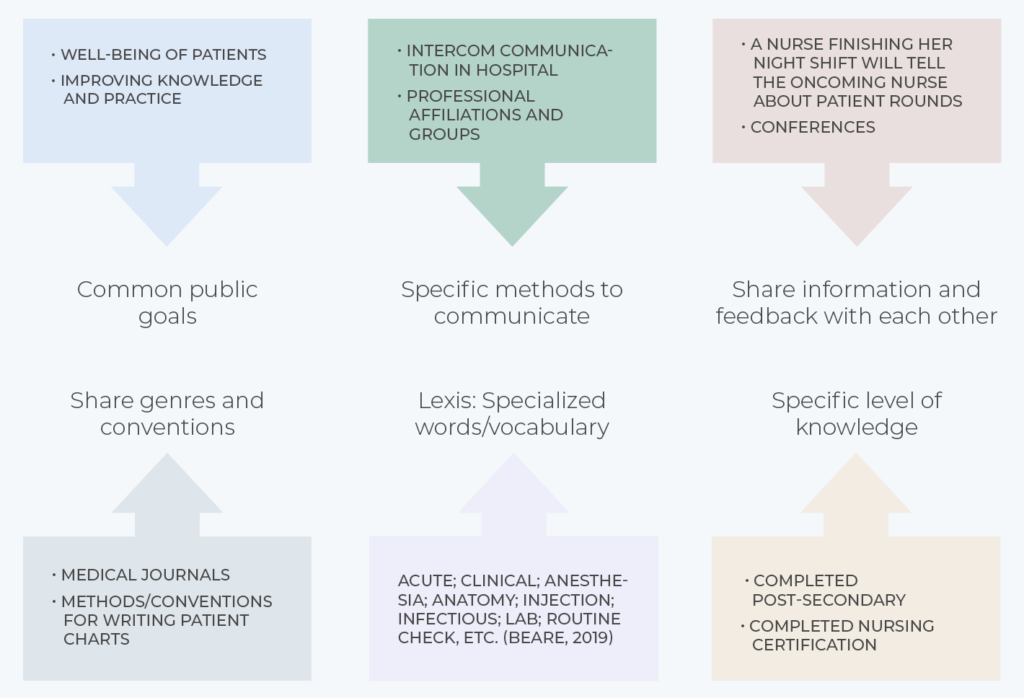6 In-Common Communication
Emilda Thavaratnam
We all have something in common with one another. Finding the “in common” element in our communications can help us forge connections and make a difference.
What You’ll Learn:
- Why good communication focuses on what we have in common with others
- How to engage in mutually respectful discourse
- Why we should seek out diverse voices
Looking for the “In Common” Element
We communicate most often with people with whom we share common goals or interests. John Swales (1990) calls these groups “discourse communities”. People in these groups have six things in common:
- Common public goals
- Specific methods to communicate
- Share information and feedback in a participatory manner
- Share genres and conventions
- Lexis: specialized words/vocabulary
- Specific level of knowledge needed for membership (Swales, 1990, pp. 471–73)
We all participate in many discourse communities. Some discourse communities you may be part of include:

Family and friend groups

Sports teams

School communities

Specialized social media groups
Now, take a look at an example of a specific discourse community.
Nurses

Considering what you have in common with others can help you solve points of disagreement and resolve difficult situations.
Take the example of a disagreement between a nurse and a patient’s family. The family is concerned about the way the nurse is handling the care of their loved one. What should they do, and how might finding the “in-common” element affect their communication?
| DON’T | DO |
|---|---|
| Scream, yell, or use abusive language. | Remember the in-common element—“the patient.” Nurses deeply care for their patients. This nurse may have missed the call, is attending to another patient, or is on the verge of coming to your room. |
| Family member: “Where are you? You are extremely slow! I’ve buzzed your station three times and you haven’t come to see if my mother is ok?” | Family member: “Hi there, I’m so sorry to buzz again, but is there any way you can bring my mother another painkiller? Her back is hurting her.” |
Regardless of whether you share a discourse community, it is possible to find elements in common, and doing this ensures respectful and effective communication.
Reflect: Think about the last time you had a disagreement with someone.
- What was the disagreement about?
- Were you from the same discourse community?
- What in-common element did you have?
- How did the conflict resolve?
- What could you and the other person do differently next time?

Members of discourse communities use specific types of communication known as rhetorical modes. For example, a chef may use process analysis to write a recipe for a magazine. Click here to learn about the various types of rhetorical modes.
Civil Discourse
Civil discourse is when we listen and have gracious discussions with someone whose ideas are different than ours. It involves removing our assumptions and demonstrating mutual respect, open-mindedness, humility, and integrity.
Watch this source for an introduction to civil discourse.
Andrea Leskes in her “A Plea for Civil Discourse: Needed, the Academy’s Leadership” (2013) shares effective ways to engage in civil discourse:
- Focus on the issue and not the person (avoid personal attacks).
- Thoughtfully listen to the other perspective.
- Look for areas of disagreement and points of commonality.
- Concede/admit the validity of the other side.
- Defend your ideas with verified information.
- Treat other ideas with respect.
- Avoid violence (physical, emotional, and verbal).
- Be humble, open-minded, and willing to change.
Here is an example of a debate that uses strategies from Leske’s model. In this video, popular children’s show host Mr. Rogers requests an increase in government funding to keep his show on air.
| Focus on the issue and not the person (avoid personal attacks). | Mr. Rogers focuses on the issue of needing more government funding for his television show rather than personally attacking the government officials for making cutbacks. Ethos: appeals to goodwill |
| Thoughtfully listen to the other perspective. | He attentively listens and doesn’t interrupt when others are speaking. |
| Look for areas of disagreement and points of commonality. | He points out that they are all invested in making their communities a better place. |
| Defend your ideas with verified information. | He uses facts and statistics as well as his experience with children on the show to highlight his claim, which is that public television shows like his are extremely important for children. |
| Treat other ideas with respect. | His tone, mannerisms, and approach are respectful. |
| Be humble, open-minded, and willing to change. | He is very humble and does not come across as being the only one who knows anything about children’s educational programming. |
Our communication is inspired by our individual experiences, values, traditions, and native language. Civil discourse allows us to use our unique voices and showcase our perspective while respecting the opinions of others as well.
Using Leskes’s framework can be an effective brainstorming exercise when planning your communications.
Let’s practise using Leskes’s framework.
First, choose a claim that you believe to be true:
Post-secondary education does prepare students for daily life or “the real world.”
Post-secondary education does not prepare students for daily life or “the real world.”
Watch Julia Dhar’s “How to Disagree Productively and Find Common Ground” for inspiration on engaging in respectful debates.
Diverse Voices and Stories

We live in a globalized reality where powerful stories told by authors, activists, researchers, scientists, artists, and other leaders transcend borders.
Effective communication occurs when we listen to experiences and stories that are different from our own. When we question our assumptions and bias and expand our filter bubbles, we can discover what we have in common.
Storytelling
Stories are powerful communication tools. They are impactful and reveal emotions that allow others to connect with them in a meaningful way.
Kevin Eikenberry (2010) in his blog post “Five Reasons Stories Are a Powerful Communication Tool” says stories are powerful because they…
- Make a point memorable
- Make it personal, meaningful
- Create and reveal the audience’s emotions
- Build a connection to the audience
Watch Joseph Kim’s story.
In this example, Kim uses storytelling to relay a powerful message to his audience about hope and perseverance. Kim’s TED Talk, on one hand, features a unique experience that is only his. On the other hand, his mode of delivery allows him to create a connection to his audience and show the feelings of love, hope, gratitude, joy, heartache, despair, disappointment, and perseverance that we all share.
Here is how he does this:
| 1. Make a point memorable | Describes events with descriptive language and details life events using elements of storytelling. Uses an earnest tone and expression when recounting painful memories (e.g. being hungry on his birthday, losing his father, message to his sister). |
| 2. Make it personal, meaningful | Shares personal experience of losing his family. Sends a personal message to his sister at the end. |
| 3. Create and reveal the audience’s emotions | Audience’s expressions are sad, sympathetic, tearful. Kim’s is solemn, respectful. |
| 4. Build a connection to the audience | Message of hope is universal to audience. Personal experiences of love, family, overcoming adversity, new beginning, connecting and relating to others. Makes eye contact. Humble and earnest. |
Stories with diverse authors and ideas can be very powerful. Step outside your filter bubble, and listen to a story or choose a book you typically would not.
For suggestions of diverse books to read, visit this page: www.goodreads.com/shelf/show/diverse-authors
In the summer of 2018, the publisher Scholastic asked their readers to tell them why reading diverse books was important to them. Take a look at some of their moving responses here.
Reflect:
- What was the last story you encountered?
- Was it from a perspective different than your own?
- Did you agree with this perspective?
- What did you learn?
Watch and then analyze the communication between NDP leader Jagmeet Singh and an attendee at his rally.
We are part of multiple communities and have exchanges with people both within and outside of those communities. Remember the in-common element when speaking to others to avoid negative or ineffective communication.
Civil discourse makes it possible to “agree to disagree” in a gracious manner. It focuses on discussing the topic and not attacking the person. Meaningful exchanges can allow for the onset of new ideas and growth.
Listening to diverse voices and experiences allows us to venture outside our filter bubbles and grow our understanding of the world. Through diverse voices, sharing and learning becomes possible.
References
See References In-Common Communication References
Basic types of writing or communication, characterized by their purpose and the structural or rhetorical conventions used to achieve that purpose. Examples of rhetorical modes are persuasion, classification, compare and contrast, and cause and effect.

